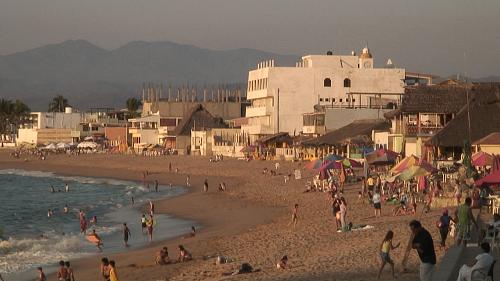


| |
 Art & Travel in Mexico: take a driving vacation to beaches from Puerto Vallarta on the Mexican Riviera Art & Travel in Mexico: take a driving vacation to beaches from Puerto Vallarta on the Mexican Riviera  | |
|
| |
Heading South to the Costa Alegre From Puerto Vallarta: An Interesting Change in SceneryRincon was our last port of call on the coast north of Puerto Vallarta (Costa Azul), and after a brief stop at San Francisco to buy Huichol native art, we headed south for Melaque on the Costa Alegre (Happy Coast) the next day. This area is often referred to in one word, ' Costalegre', and is considered to be that part of the Mexican Riviera that extends along the coast from the southern tip of the Bay of Banderas to Manazanillo. You can't avoid Puerto Vallarta when driving south, as there is no other feasible route, other than going a
long way around via Guadalajara. Fortunately, there is a bypass road that follows the base of the mountains around
the city, so we took this after stopping at Walmart to buy some shoes. We finally made it around to the
southern side of the city (Old Town), and I was glad that we had headed north when we arrived at the airport, as
the traffic was jammed and the driving was frenetic, to say the least. There's a Pemex station just on the outskirts of the south side of the city on the highway, and I would recommend you gas up there if you're heading south, as it is the last one around the bay. Even though there are several marked on the map once you turn inland from the bay, as you travel down the south coast to Melaque, we found that all but one were closed. It's not hard to get into trouble with running out of gas in Mexico, and it's a good idea to fill up any time you pass a gas station, even if your tank isn't empty. They're all the same price as they are essentially run as a Federal Government institution. The drive from PV to Boca Tomatlan (where the highway turns up into the mountains - pictured above) is very
scenic, with some good views of the When the highway turns up into the mountains at Boca de Tomatlan, it will be the last time you see the Bay of Banderas, as you begin your trip to the Costa Alegre. You might find it worthwhile to stop for lunch there, as it is a quaint little Mexican fishing village, with a number of restaurants serving up some great fresh-as-it-gets seafood. Following the gorge that carries the sparkling Tomatlan River, you'll begin your ascent into the mountains for
yet another very scenic part of the trip. Looking at the map of the Costa Alegre (below - courtesy of Google Earth), you'll see some of the coastal
villages, towns and beaches we passed while driving down south on Highway 200. There are numerous other small
settlements along the way (that also are not on the map), but we didn't have time to visit them all.
These are fertile lands, and the farms get plenty of water provided by the Cajon de Penas reservoir, which is also worth a visit if you have time. The Jalisco State coast is noted for its fine agave plantations and distilleries (picture below), and you can take plantation tours and taste the Mezcal if you wish. Note that only tequila that is made in the highlands town of Tequila, Jalisco can bear the name of "tequila." Agave, also called maguey, is an indigenous plant that is a succulent, not a cactus, and is actually related to the lily and amaryllis. Archeologists say the agave has been cultivated for at least 9,000 years.
In the distance, on the tip of the southern curve of the bay, we could see the hotels and restaurants of Barra de Navidad. I have dedicated several pages to the various places in this area, as there is much to see and experience; here's a picture of the Barra de Navidad beach, which it shares with Melaque, just as everything starts turning to gold as the sunset approaches:
NEXT DESTINATION: Barra de Navidad |
YOU ARE HERE > HOME > COSTA ALEGRE
|
| TRAVEL & ART in MEXICO - MENU |
HOME COSTA AZUL Sayulita Bungalow Rentals Villa Rentals San Francisco (San Pancho) Rincon de Guayabitos Chacala BAY OF BANDERAS Puerto Vallarta Puerto Vallarta Via Boeing 787 Soon COSTA ALEGRE Barra de Navidad Melaque Cuastecomate Tenacatita Cihuatlan - Carlos Santana walked here COLIMA STATE Manzanillo Colima City Volcano of Fire Colima Volcano Satellite Photo MAYAN RIVIERA MEXICO WEATHER
This website was created with XSitePro and is hosted by our sister company - AeroHOST Web Systems
Copyright © 2002-2008 - Mexico Art and Travel - All Rights Reserved

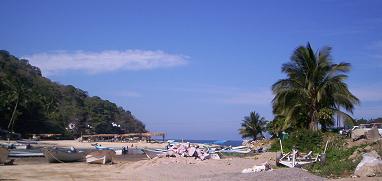
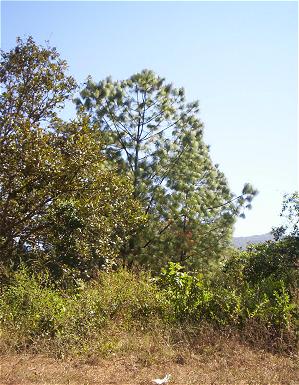 Bahia of Banderas as the road winds around the base of the mountains, often several hundred feet
up. On the way around the bay, you'll pass the famous site of John Huston's restaurant at the little
village of Mismaloya, where the original film set of 'The Night of the Iguana' can still be toured. We missed
it because it doesn't open until 4 PM, so plan accordingly if you want to visit the site. The production of
this film was a defining event for this region, essentially starting its reputation as a vacation
paradise. There are numerous hotels, villas and resorts in this area if you choose to stay for a
while.
Bahia of Banderas as the road winds around the base of the mountains, often several hundred feet
up. On the way around the bay, you'll pass the famous site of John Huston's restaurant at the little
village of Mismaloya, where the original film set of 'The Night of the Iguana' can still be toured. We missed
it because it doesn't open until 4 PM, so plan accordingly if you want to visit the site. The production of
this film was a defining event for this region, essentially starting its reputation as a vacation
paradise. There are numerous hotels, villas and resorts in this area if you choose to stay for a
while.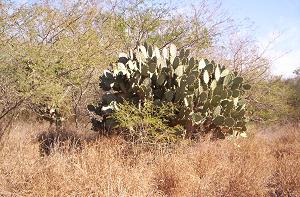 It ascends some 2,000' up into the pine forest environment, where the canopy gradually changes from
the lush jungle environment of the coast, to a mix of long needle pine and thorn bush (picture above). As you
descend from the mountains back to the coast, it becomes noticeably drier, and even some cactus appear, mixed
in with the thorn bushes.
It ascends some 2,000' up into the pine forest environment, where the canopy gradually changes from
the lush jungle environment of the coast, to a mix of long needle pine and thorn bush (picture above). As you
descend from the mountains back to the coast, it becomes noticeably drier, and even some cactus appear, mixed
in with the thorn bushes.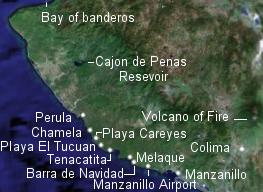 The highway in this area is not busy, so the drive is considerably less stressful than the route
through the Costa Azul, north of Vallarta.
The highway in this area is not busy, so the drive is considerably less stressful than the route
through the Costa Azul, north of Vallarta.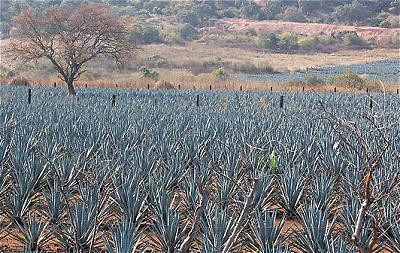 We headed directly for the Melaque and Barra de Navidad area, as we had heard it was a great place,
and we certainly weren't disappointed. We rounded the final bend as we climbed over the low lying hills in the
area, and the spectacle of the Melaque area suddenly appeared before us on the valley floor. The town
itself sits on the sheltered, sparkling waters of the Bahia de Navidad, with a valley filled with farms and
orchards stretching far up into the mountains, almost as far as the eye can see.
We headed directly for the Melaque and Barra de Navidad area, as we had heard it was a great place,
and we certainly weren't disappointed. We rounded the final bend as we climbed over the low lying hills in the
area, and the spectacle of the Melaque area suddenly appeared before us on the valley floor. The town
itself sits on the sheltered, sparkling waters of the Bahia de Navidad, with a valley filled with farms and
orchards stretching far up into the mountains, almost as far as the eye can see.